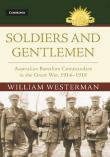AustLit
Latest Issues
AbstractHistoryArchive Description
Soldiers and Gentlemen: Australian Battalion Commanders in the Great War, 1914-1918 is the first book to examine the background, role and conduct of Australian commanding officers during the First World War. Though they held positions of power, commanding officers inhabited a leadership no man's land - they exerted great influence over their units, but they were also largely excluded from the decision-making process and faced the same risks as junior officers on the battlefield. A soldier's well-being and success in battle was heavily dependent on a commanding officer's competence, but little is known about the men who filled these roles. In his groundbreaking book, William Westerman explores the stories of the vitally important, yet often forgotten, commanding officers. Theirs is a story of the timeless challenges of military leadership, and this book prevents them from slipping from the public memory to enhance our knowledge of the conflict. (Publication Summary)
Publication Details of Only Known VersionEarliest 2 Known Versions of
Works about this Work
-
[Review] Soldiers and Gentlemen: Australian Battalion Commanders in the Great War, 1914–1918
2017
single work
review
— Appears in: History Australia , vol. 14 no. 4 2017; (p. 672-674)
— Review of Soldiers and Gentlemen: Australian Battalion Commanders in the Great War, 1914–1918 2017 single work biography'During an address to American soldiers at Fort Knox, the British general Sir William Slim outlined his now-famous views on leadership. He mused that ‘leadership is the most intensely personal thing there is in the world, because leadership is just plain you … leadership is the projection of your personality, so it is not much good starting off to be a leader unless you have got a personality’. 1 Slim’s maxims have a timeless quality, referred to by modern business and militaries alike. William Westerman’s Soldiers and Gentlemen highlights the importance of personality and personal leadership to the successful performance of Australian battalion commanders during the First World War. In both British and Australian popular memory of the First World War, command is traditionally viewed in a negative manner, callously responsible for the blooding of the ‘Poor Bloody Infantry’ at the front. Yet, as Westerman rightly points out, Australia’s fixation with the humble ‘digger’ on the front line and ‘Great Captains’ such as John Monash, Thomas Blamey and Gordon Bennett has obscured our understanding of the important mid- and low-level commands that sit in the gulf between. A welcome addition to the canon of First World War military history, then, Westerman’s Soldiers and Gentlemen breathes life into the experiences of the 183 substantive Australian battalion commanders (or COs [Commanding Officers]), who were both the great captains and the men in the trenches (5), tracing their fortunes from the raising of the Australian Imperial Force (AIF) in 1914 to the final Hundred Days offensive in 1918. Aligning Australian battalion command’s expansion and improvement to the well-worn concept of the ‘learning curve’, Westerman provides us with a solid, well-researched piece of historical recovery.' (Introduction)
-
[Review] Soldiers and Gentlemen: Australian Battalion Commanders in the Great War, 1914–1918
2017
single work
review
— Appears in: History Australia , vol. 14 no. 4 2017; (p. 672-674)
— Review of Soldiers and Gentlemen: Australian Battalion Commanders in the Great War, 1914–1918 2017 single work biography'During an address to American soldiers at Fort Knox, the British general Sir William Slim outlined his now-famous views on leadership. He mused that ‘leadership is the most intensely personal thing there is in the world, because leadership is just plain you … leadership is the projection of your personality, so it is not much good starting off to be a leader unless you have got a personality’. 1 Slim’s maxims have a timeless quality, referred to by modern business and militaries alike. William Westerman’s Soldiers and Gentlemen highlights the importance of personality and personal leadership to the successful performance of Australian battalion commanders during the First World War. In both British and Australian popular memory of the First World War, command is traditionally viewed in a negative manner, callously responsible for the blooding of the ‘Poor Bloody Infantry’ at the front. Yet, as Westerman rightly points out, Australia’s fixation with the humble ‘digger’ on the front line and ‘Great Captains’ such as John Monash, Thomas Blamey and Gordon Bennett has obscured our understanding of the important mid- and low-level commands that sit in the gulf between. A welcome addition to the canon of First World War military history, then, Westerman’s Soldiers and Gentlemen breathes life into the experiences of the 183 substantive Australian battalion commanders (or COs [Commanding Officers]), who were both the great captains and the men in the trenches (5), tracing their fortunes from the raising of the Australian Imperial Force (AIF) in 1914 to the final Hundred Days offensive in 1918. Aligning Australian battalion command’s expansion and improvement to the well-worn concept of the ‘learning curve’, Westerman provides us with a solid, well-researched piece of historical recovery.' (Introduction)




